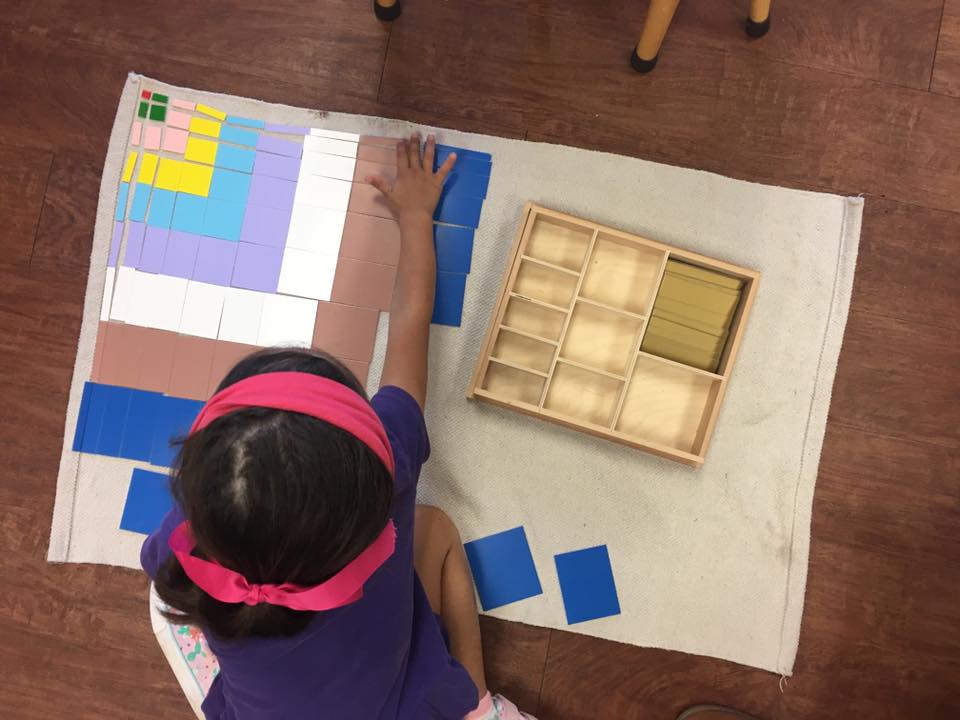Sensorial Impressions
Imagine back to when you were an infant. Hard to remember your thoughts, likes, dislikes? Of course it is. An infant cannot speak, walk, or move their bodies intentionally therefore, a child's main source of information gathering is through his sense of taste (gustatory), touch (tactile), smell (olfactory), sight (visual), and hearing (auditory). An infant has no preconceived notions of the world around him. Thus, he gathers impressions through his senses to help him develop a connection between his inner self and the outside world.
Before a child joins us in the Children’s House, he has acquired millions of impressions of the world around him. Dr. Montessori realized this and created materials that could isolate a specific quality in order to refine a particular sense. She realized the value in refining the senses. It helps to develop scientific precision, classification of impressions, an orderly mind, and indirect preparation of writing through finger grip and control of a pencil.
Note: In addition to the following categories and impressions, we must mention that Sensorial materials include Geography, Biology, Botany, Music and Art extensions. We will discuss these components in a different Blog post.
“The education of the senses is of the highest pedagogic interest...The development of the senses precedes that of the higher intellectual powers and in the child between three and six years of age, it is in the formative period. We can then help the development of the senses during this very period, graduating and adapting the stimuli just as we ought, to aid the acquisition of speech before it is completely developed. All the education of the early childhood ought to be based on this principle-to aid the natural development of the child.”
Visual
Dr. Maria Montessori designed the Sensorial materials to isolate a sense purposefully. In each activity, a child gets to develop their specific sense through repetition. Unlike the Practical Life activities which the child sees daily and experiences in his home environment, Sensorial materials are an absolutely new experiment for him. Montessori designed different materials to let the child mature his visual sense. Some activities let him discriminate size, while others identify shape or color. The experiments can take place by matching or grading. For instance, in Color Tablet boxes, the young child gets to match the primary colors and later they learn to match more color tablets. At last, the child learns to grade from the darkest to the lightest shades of one color. Through a better observation, a child learns to find different color items in the environment and match these item to the color tablets. In matching geometry cabinet shapes from a distance, the child trains their brain to fully take in the size and form of a shape in order to match it to the corresponding inset.





Tactile
The child gets to learn his environment through his senses. When the child has the ability to freely discover his environment and be exposed to the right sensory material, he then can classify things around him and organize his intelligence. Dr. Montessori designed the sensorial materials in a way to help the child to control his work without the grownups help. Every material has a control of error, meaning that through practice, the child learns to finish his work perfectly. Touch Tablets, Touch Board and Fabrics are a few sensorial materials which are fully isolating the tactile sense. The child gets to literally use his finger tips to touch the surface to either match or grade tablets or different fabrics.
“…the function of the sensorial materials is not to present the child with new impressions (of size, shape, color and so forth) but to bring order and system into the myriad impressions that he has already received and is still receiving.”
Stereognostic Activities
Stereognostic activities strengthen the child’s ability to become familiarized and furthermore identify objects based on touch alone. This entices the child to explore the world on a higher mental level. For example, a child holds an egg in their hand and is able to classify that it is not just an “egg”, rather it is a geometric solid that is called ovoid. It allows them to create what Montessori described as a touchstone toward a lifetime tendency for order, precision and recall.
Language is always introduced once the child displays an accurate abstract memory of a concept. This helps the child precisely communicate qualities and names of experiences they first had stereognostically. An example of this could be, “A cube has a base shape of a square.” Other purposes of stereognostic activities aside from development of the Stereognostic sense include: development of the ability to visualize mentally, development of tactile and muscular memory and awareness of geometric shapes that surround us.


Gustatory, Olfactory and Auditory
In the Montessori environment, the children are able to explore taste, smell and sound. Dr. Maria Montessori developed materials enabling the children to isolate a sensory quality, the ability to handle the material, materialized abstraction and the benefit of control of error. The tasting bottles is a work that helps isolate the four fundamental tastes of sweet, sour, bitter and saline. The development of the olfactory sense is aided through the work of the smelling bottles. These bottles are filled with familiar substances in order to help the child start to classify certain smells. Rounding out the sensorial works are those of the sound boxes and the bells. The sound boxes are used to develop the discrimination of volume while the bells develop and refine the the auditory sense for pitch.
Even with the materials Dr. Montessori provided for the children, there are so many opportunities for the refinement of taste, smell and sound in the classroom and at home. In the classroom environment, we enjoy the smells of the baking work, taste new foods for snack, and enjoy the sounds of our voices singing at circle time. The opportunity to create these impressions at home are abundant. Take for instance the tastes, smells and sounds of every day life. Do you remember as a child waking up to the smells of your mother preparing pancakes for your breakfast? The smell of your father’s aftershave cologne? The sound of your grandfather chopping wood? Take time to create these amazing experiences for your child. These are impressions that will last a life time and bring fond memories of you as an adult.






Visual Sense: Mixed Impressions of Form and Color
These exercises are directly related to preparing the child for a deeper understand of mathematical processes; specifically, algebra and geometry. Once the child has had a great deal of exposure to materials that isolate one quality such as texture, color, sound, weight, smell, etc. the child will be presented with materials that offer two visual appearances. The visual appearances change in both form and color. These materials include the constructive triangles, binomial and trinomial cubes, superimposed geometric figures, decanomal square and knobless cylinders. All of these materials are further analyzed in Montessori Lower and Upper Elementary programs.
“Every series of objects… is graded so that there is a maximum and a minimum, which determines its limits, or which, more properly, are fixed by the use which a child makes of them.”
With the Binomial and Trinomial cubes, the children learn to identify a mechanical control of error and are indirectly introduced to the algebraic equations for the Pythagoras theorems in a sensorial context. With the graded geometric figures, the child is exposed to preparation for ornamental geometry as they super impose shapes, create patterns and explore the relation between plan figures. The six boxes of Constructive Triangles offer the child several opportunities to build quadrilaterals, equilateral triangles and hexagonal shapes from various types of triangles. They also learn vocabulary for these qualities and parts of these figures such as base, height, apex, bisector, etc. The Sensorial Decanomial teaches the child to understand squaring through discrimination of size, shape and color. The Knobless Cylinders could be described as the “king of the Sensorial Materials.” Once the child understands all of the possible combinations of dimension, she will have an opportunity to observe and compare the different series with each other.





A Peek Inside Our Children's House Classrooms
Bobcats
I would like to express my excitement for our children becoming more normalize and comfortable in the classroom. The bakers are excited to try the new recipe Cream Drop Biscuits.. We are going to practice this recipe for the next couple of months to give our bakers the chance to learn the measurements and steps through repetition. We have been gardening and the children are thrilled to see seeds grow; it gives them more motivation take care of them daily. We are honor to have the parents observe the classroom in few days and we hope to see everyone at our next community meeting discussing “Sensorial in Children House” .
Thank you for the continues support.
Ms. Mahsa and Ms. Dinora














Cactus Wren
Wow!! Can you believe that October is almost over!! It has been very nice having cooler weather. The children are able to enjoy our beautiful revamped outdoor environment. We planted strawberries, cucumbers, radishes, cilantro, mint, tomatoes, and squash. The children are excited every day to work in our flourishing garden. We also discovered a caterpillar on one of our citrus trees. We placed it in our butterfly compound and with a little research, we discovered that it will soon be a swallowtail butterfly. It has begun to transform into a chrysalis. We just can't wait!!
We hope everyone had a wonderful and restful fall break. The children shared their adventures and are now ready to work. Thank you all for your support and for letting us be part of your child's amazing journey.
Peacefully,
Ms. Johna and Ms. Eugenia










Gray Fox
October was a fantastic month of continued growth in the environment. The children have appreciated the cooler temperatures, opportunities to garden and observe wildlife in our outdoor environment. We have been singing more songs and reciting poems about Fall. It is a delightful time of year for the child of three-to-six because it lends so many opportunities for sensorial development. The children enjoyed sticking their hands inside of pumpkin to feel the fibrous strands and seeds. Afterwards, they enjoyed roasting and tasting the seeds. We are looking forward to many more opportunities for exploration throughout November and December. Thank you to all who attended our Fall social and to Carly Loranger for your efforts in creating a wonderful night of bonding.
Respectfully,
Ms. Lauren and Ms. Yadira












